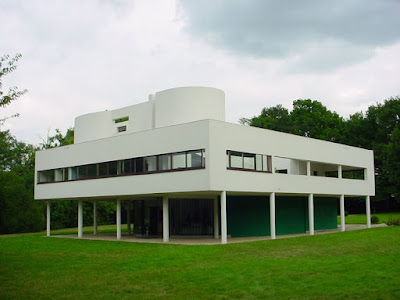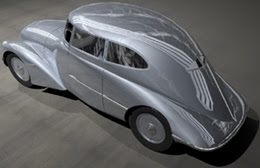Avangarda 20
 Vladimir Tatlin - Model of the Monument for the Third International, 1920
Vladimir Tatlin - Model of the Monument for the Third International, 1920
(Modernism - Designing a New World - 1919 - 1939, exhibition at Corcoran Gallery of Art)
Washingtonians have been spoiled this year with the Avant-Garde of the 20s and 30s. A photo exhibition of the Central-European Modernism is currently on view at the National Gallery, in parallel with the one at Corcoran. The collection of Société Anonyme toured at Phillips, in parallel with the Prouns of El Lissitzky. A Paul Klee exhibition was earlier this year at Philipps, and Dadaists had their turn, at the National Gallery. Each exhibition, a must for anyone aiming to understand the Avant-Garde in all its dimensions.
The exposition at Corcoran starts in the lobby with a splendid prototype of a saloon car, a Tatra from 1933. You follow the monumental marble stairs, flanked by two rows of red and blue chairs (the Rietveld chairs) and you enter the rotonda.
A model of the Tatlin Tower is in the middle of the rotonda: the Monument for the Third International. It had been designed as a twin helix up to 400 m in height, supporting three enormous rotating geometric structures: a large cylinder (rotation spanning a year), a pyramid (rotation in a month), and a thin cylinder (rotation in a day). Each structure with its own destination: venue for conferences, executive offices, information center. An open-air screen was planned to be installed on top, and a projector, to cast the Revolution over clouds. As materials, glass (the transparency of Communist ideals), and steel (the strength of Communism). The tower was never built: some would say that too much transparency was not what Communist leaders were looking for. Anyway, it would have consumed all steel available at that time from all over Russia.
I had read a lot about it. Now I was in front of the model; the three geometric structures were doing slowly their rotations and a music was heard, faintly: astral music would have sounded the same way.
Tatlin Tower, one of the places where was the beginning. The moment zero of the Avant-Garde. I remained silent in front of the model, as to make sure it was not a dream, that I was there. Yes, I was, and I was able now to see all its details, to observe the rotations, to look through the glass inside the large cylinder, the pyramid, the thin cylinder. The monument never built, for always a dream.
Tatlin Tower carries one of the dimensions of the Avant-Garde: the political dimension; the epoch requested a strong political commitment and the artists answered with great enthusiasm. The Avant-Garde of the 20s created under the banner of Utopia, to face in the 30s the reality of dictatorships. From Utopia to Dystopia, that was the life cycle.
The model of the monument of Tatlin is surrounded in the rotonda by four other exhibits, that show us other dimensions of the Avant-Garde of the 20's.

Firstly, the model of Villa Savoye à Poissy, created by Le Corbusier in 1928. It is his seminal work: the house viewed as a machine à habiter. The industry was imposing its structures over all other domains. The new principles of urbanism and of housing were following industrial claims for efficiency and standards. Villa Savoye has a modern elegance while being strictly functional.
The floor was elevated as the house was built in a meadow, on damp ground. The floor was made of reinforced concrete and was supported by thin columns. Inside the house the load bearing walls were no more necessary, so the space allowed flexible partitioning. Horizontal windows were providing natural illumination and ventilation. The façade was a thin skin of wall and windows. The flat roof included the garden area.
 Another exhibit in the rotonda is the Savoy Vase designed by Alvar Aalto. It also has its story. Aalto designed the vase for a national competition in Finland. He won the competition and his works were shown at the Finnish pavilion of the Paris World Fair, in 1937. The vase took its name from the Savoy Restaurant in Helsinki, that opened in 1937, with Aalto's vases on each table.
Another exhibit in the rotonda is the Savoy Vase designed by Alvar Aalto. It also has its story. Aalto designed the vase for a national competition in Finland. He won the competition and his works were shown at the Finnish pavilion of the Paris World Fair, in 1937. The vase took its name from the Savoy Restaurant in Helsinki, that opened in 1937, with Aalto's vases on each table.To understand the logic of the whimsical form of the vase, you should compare it with the auditorium of the Viipuri Municipal Library, designed by Aalto in the 30s. You'll realise that the shapes of the vase (as well as the shapes of the roof in Viipuri) belong to the universe of the Avant-Garde: it is the universe beyond cubism, the same universe found in the sculptures of Arp and Miró. In the same time, the shapes of the Savoy Vase (and of the roof in Viipuri) call in mind the shapes of the Finnish landscape. Alvar Aalto, like Brancusi, knew how to read their ethnic universe with the international alphabet of the time, while finding in the international universe their ethnic paradigms.

The next exhibit: the Red and Blue Chair designed by Gerrit Rietveld, the same model as the ones from the marble stairs. Rietveld designed it in 1917 and used one color, black. One year later he joined De Stijl and changed the colors of the chair to fit Mondrian's palette; and so the lines became planes, red and blue: Mondrian's world exploring the tridimensional.

And here is the forth exhibit surrounding Tatlin Tower: the so-called Wassily Chair designed by Marcel Breuer.
It is a spare skeleton of intersecting planes. Breuer used for the frame gleaming tubular steel - inspired by the bike he was riding to and from Bauhaus where he was teaching. AS the story goes, no bike manufacturer was interested in the project, so Breuer built the prototype with the help of a plummer.
Wassily Kandinski, who was teaching at Bauhaus by the same time, was a great admirer of the prototype, so the chair took eventually his name: the Wassily Chair.
Le Corbusier, Aalto, Rietveld, Breuer, all of them were architects and designers. Tatlin, Malevich, El Lissitzky, were also architects. Bayer and Burchartz were photographers and designers. Man Ray was painter and photographer. And here lies the utilitarian dimension of the Avant-Garde of the 20s - the openness toward the utilitarian, and the emphasis on architecture, as the expression of total art. Art Nouveau had started the dialog with the utilitarian, the Avant-Garde would push this dialog to its ultimate consequences.
Walter Gropius was saying in the Bauhaus Manifesto, the ultimate aim of all creativity is a building, and, architects, painters, sculptors, we must all return to crafts.
The exhibits from the rotonda give us yet another dimension of the Avant-Garde: the artistic dimension; the search for the truth that exists beyond cubism
The rotonda, with the model of Tatlin Tower in the middle gives the political dimension of the Avant-Garde, while the surrounding exhibits add the emphasis on architecture and utilitarian and carry with them the post-cubist flavor. The Tatra car from the lobby shows the industrial dimension of the Avant-Garde of the 20s and 30s: the aim of embedding art in industry. The fully integration of art and life, this was the goal of the Avant-Garde.

And then follow the halls of the exhibition: hundreds of exhibits, photos, drawings, posters, paintings, fragments of movies, books, magazines. It is organized by the Victoria and Albert Museum from London.
I hope I will come back to each dimension to take it in depth. Here was only the outline.
- Modernism in Central Europe
- Paul Klee at the Phillips Collection
- Paris - La Maison de Verre
- Washington, Embassy Row: The Finnish House
- Casa Malaparte
- The Wonderful World of Bruno Taut
- Wenzel Hablik - Projects for a Crystalline Architecture
- Suprematism and Constructivism
- Surrealists and Stuff
- A Drawing by Joan Miró
- Man Ray - Jacqueline Goddard
- Mannahatta
- Filmele Avangardei
- Kurt Jobst, Goldsmith and Silversmith
- The Goldsmith from Jo'burg
- The Book about Kurt Jobst - Courtesy of Sandy Lutrin
- Kleine Welten
- American Avant Garde
- Picasso et les Maîtres
- Man Ray at the American Art Museum
- Man Ray and Marcel Duchamp Playing Chess
- Two Portraits of Manhattan
- The Art of Political Manifesto: George Grosz
- The Chaise Longue of Alvar Aalto
- Man Ray - a video by arwen987
- A Picasso Sold At $106.5 Million
- Lion's Signature
- George Ault
- The Windows of Paul Delvaux
- Majakovsky
- Surrealism Heroes
- Brancusi Filmed (1929-1939)
- Otto Dix
- Joan Miró
- NY Times: On the Bauhaus Trail in Germany
- El Centenario de la Línea y el Cuadrado
- Del Sueño a la Pesadilla
- Konstantin Yuon
Labels: Alvar Aalto

0 Comments:
Post a Comment
<< Home